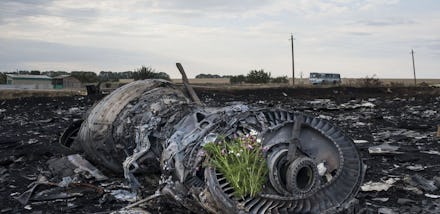Investigators Say 'High-Energy Objects' Brought Down Malaysia Airlines Flight MH17

They've confirmed what we already know: In a preliminary report on the downing of Malaysia Airlines Flight MH17 over eastern Ukraine in July, the Dutch Safety Board has concluded that the passenger jet broke apart due to impact from "a large number of high-energy objects."
[MH17] broke up in the air probably as the result of structural damage caused by a large number of high-energy objects that penetrated the aircraft from outside. There are no indications that the MH17 crash was caused by a technical fault or by actions of the crew.The cockpit voice recorder, the flight data recorder and data from air traffic control all suggest that flight MH17 proceeded as normal until 13:20:03 (UTC), after which it ended abruptly. A full listening of the communications among the crew members in the cockpit recorded on the cockpit voice recorder revealed no signs of any technical faults or an emergency situation. Neither were any warning tones heard in the cockpit that might have pointed to technical problems. The flight data recorder registered no aircraft system warnings, and aircraft engine parameters were consistent with normal operation during the flight. The radio communications with Ukrainian air traffic control confirm that no emergency call was made by the cockpit crew. The final calls by Ukrainian air traffic control made between 13.20:00 and 13.22:02 (UTC) remained unanswered.
"The MH17 crash has shocked the world and raised many questions. The Dutch Safety Board wishes to determine the cause of the crash, for the sake of the loved ones of the victims and for society at large," said Dutch Safety Board Chairman Tjibbe Joustra.
"The initial results of the investigation point towards an external cause of the MH17 crash. More research will be necessary to determine the cause with greater precision. The Safety Board believes that additional evidence will become available for investigation in the period ahead."
Even though the report doesn't explicitly mention a missile, Jane's Defense Weekly analyst Tim Ripley told Reuters that "impact with a large number of fragments would be consistent with a 'proximity' warhead, designed to explode in the air and hurl shrapnel at its target." Such warheads, Reuters notes, can be "fitted to a number of missiles, including the Russian-made BUK surface-to-air missile that Ukraine and Western allies, including the United States, say was fired by separatists who probably hit the airliner by accident."
The U.S. and Ukraine have blamed Russian-backed separatists and, in turn, Russia for the downing of the plane July 17.
The crash killed all 298 people on board, two-thirds of them from the Netherlands.